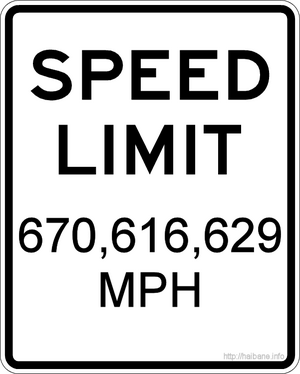German scientists claimed to have broken the speed of light:
Günter Nimtz and Alfons Stahlhofen of the University of Koblenz, Germany, have been researching a phenomenon known as quantum tunnelling. Two prisms are placed together. When a light is shown through the prisms, a detector picks up the light and records information about the photon. However, when the two prisms are separated, Nimtz and Stahlhofen discovered that photons would occasionally “tunnel” between the prisms — arriving at the detector sooner than should theoretically be possible.
The two scientists say they have now tunneled photons “instantaneously” across a distance of up to one meter. Their conclusion, stated in a recent paper, is that the speed limit of special relativity has been violated. Dr. Nimtz claims quantum tunneling is a little understood process that is “the most important” aspect of quantum physics, one that may be responsible for the computational efficiency of the human brain.
Now, color me skeptical of anything that cuts across the scientific establishment consensus, that gets published in popular press and arXiv rather than genuine peer review. My first reaction to this news was, could these professional scientists have made the first-year undergraduate error of confusing group velocity for velocity? As it turns out, yes.
how are these authors measuring an excessive speed of light? In practical terms, most experiments measure light in terms of what is called the group velocity, which is how fast a pulse propagates along an underlying carrier frequency. This can, in some circumstances, lead to the pulses traveling faster than the speed of light in the medium they’re in, but not faster than light in vacuum. Although the setup in the new paper is not entirely clear, they were measuring the arrival time of pulses, which means we’re talking about group velocity rather than the actual speed of light.
Another problem that occurs in these experiments comes from determining when the pulse actually arrived. If you analyze a pulse of light, you find that it is made up of a huge number of frequencies that, as you move away from the fundamental frequency, get lower and lower in amplitude. Once you look at the experimental set up in detail, you find that it is triggering on the pre-pulse noise generated by these high frequency components.
Sorry, but the days of solitary German geniuses laboring in their spare time to overturn all of known physics with their rogue insights is long over. In the meantime, let this be a warning to all others who dare to make the attempt at unseating Einstein:

6 responses to “speed trap”
the aliasing looked horrible so i made a new thumbnail; click on the image for a high-res version.
Let me hasten to point out that it’s the overturning all known laws of physics part whose days are long past. Solitary German geniuses laboring in their spare time we will always have with us. 😉
The ars technica writer and you are apparently confusing group velocity and phase velocity…
are you sure, Kayle? I always thought that group velocity can exceed c (or even be negative).
after a casual google I found a pretty cool applet online that demonstrates the difference.
Aha, now I “understand” where I’ve gone wrong… (Damn EE physics) http://www.mathpages.com/home/kmath210/kmath210.htm
My science teacher was looking for one of these signs with miles per second, but this works! 🙂